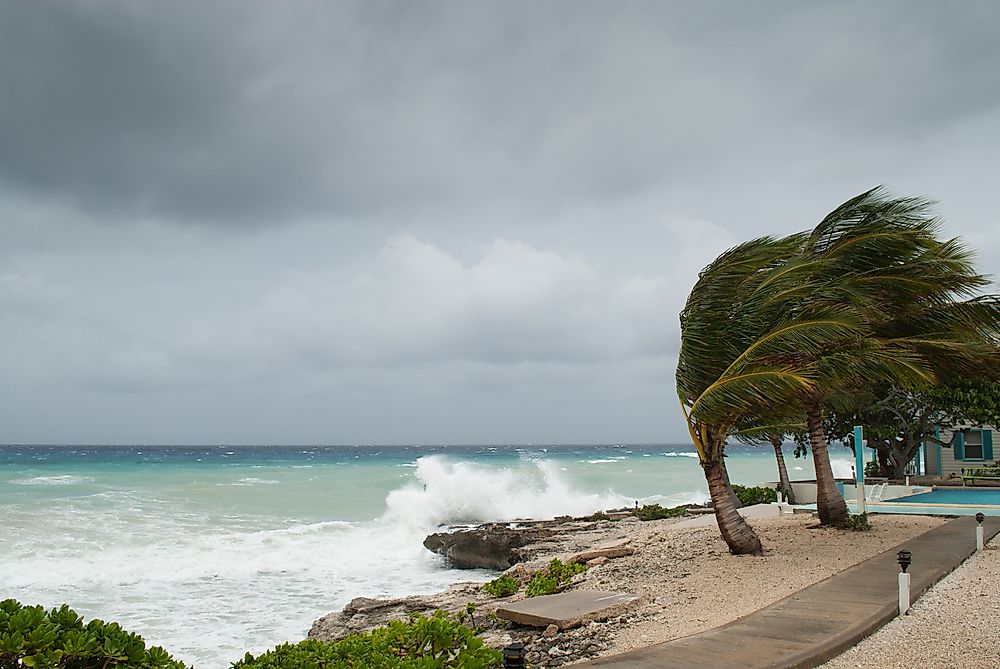What is the Saffir-Simpson Scale?

The Saffir-Simpson scale, also known as SSHWS, is used to classify hurricanes and tropical storms. A tropical cyclone in the western hemisphere that surpasses the limit of tropical storms and depressions is classified as a hurricane. The particular tropical storm must have maximally sustained winds traveling at least between 74-95 miles per hour. The highest ranking hurricane on the Saffir-Simpson scale is Category 5 which is reserved for winds and storms blowing at more than 157 miles per hour.
The Saffir-Simpson Scale Categories
Category 1
Storms in Category 1 are dangerous with their sustained winds traveling at 74 – 95 miles per hour. These storms can cause some damage to most well-constructed structures. These damages occur on roofs, vinyl siding and gutters, and also on shingles. The storms may also snap loose tree branches and uproot shallowly planted trees. Extensive damage to power poles and lines might cause power outages for several days. Coastal flooding and pier damages are often associated with these hurricanes. Examples of Category 1 storms include the Danny in 1985, the Issac in 2012, and the Newton in 2016.
Category 2
Here, the storms are extremely dangerous with a speed of 96 to 110 miles per hour which causes extensive damage to well constructed permanent structures and can blow off roofs, and damage windows and doors. Poorly established signs and piers also receive considerable damage. Many trees are snapped or uprooted. The storm also destroys mobile homes and manufactured homes. There is near total power outage, and potable water becomes hard to find. Examples of such storms are Diana (1990), Tomas (2010), and Arthur (2014).
Category 3
These are major hurricanes occurring in the Eastern Pacific or Atlantic basins. They blow at a speed of 111-129 miles per hour. The storms cause considerable damage to utility buildings and small residences with manufactured materials, minor curtain wall fractures, or wood framed houses. Also, buildings with a weak foundation like mobile homes are destroyed while gable-end roofs get peeled off. Many trees are snapped or uprooted, terrains flood, there is almost total power loss, and coastal regions may be severely damaged. Examples of Category 3 hurricanes are Isidore (2002), Karl (2010), and Otto (2016).
Category 4
Category 4 hurricanes are catastrophic. Traveling at 130-156 miles per hour, these storms will cause extensive curtain wall failures, and complete structural failure is witnessed in small residences. Trees are uprooted or snapped. The storm flattens mobile and manufactured homes. Gas station canopies are almost destroyed and power outages occur for a long time. The most memorable Category 4 hurricane was the 1900 Galveston hurricane. Others are the Hazel (1954), Charley (2004), and Joaquin (2015).
Category 5
This rank categorizes the most dangerous and catastrophic hurricanes in human history. With winds traveling at a minimum of 157 miles per hour, a high percentage of damage occurs. In framed houses, damage includes total roof failure, collapsing walls, smashed windows and doors, and flattening of many residential houses. Very few structures can withstand the velocity of such hurricanes like those located 3 to 5 miles inland such as condominiums, hotels, apartments and offices with solid steel or concrete foundations. Structures with hurricane resistance safety glasses and those covered with shutters, buildings reinforced with cement/concrete blocks with hipped roofs and an oblique angle of more than 35 degrees and no overhangs can also survive these storms. All trees are uprooted and debarked. Power outages may last several months. In general, areas hit with such hurricanes are uninhabitable for several weeks or months.
The Saffir-Simpson Scale Measurement
The scale was developed in 1971. Since then, it has undergone various modifications. An earlier version called the Saffir-Simpson Hurricane Scale took into account storm surges, central pressure, and wind speeds when determining damage. Obtaining information on storm surges and pressure is hard. Storm surges of hurricanes produce smaller or larger waves that categorized them in different rankings than what their sustained winds would. As such, National Oceanic and Atmospheric Administration (NOAA) decided that the scale should be modified to use only wind speed because wind is a more consistent way of measuring a hurricane's intensity.











